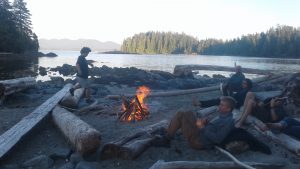
In Summer 2017, I, along with 11 other students, had the amazing opportunity to do archaeology in the Broken Group Islands. We worked and lived together for three weeks, camping on Tl’ihuuw’a (Nettle Island) and commuting daily by boat to Kakmakimilh (Keith Island). The project would not have been possible without the dedication of the project directors and staff, but most importantly the collaborative efforts and assistance from the Tseshaht First Nation. Despite facing immense challenges, the Tseshaht have not only survived, but succeed in maintaining a vibrant culture with deep ties to their home and cultural history. Talking with Tseshaht community members, including the Beachkeepers, our cook Wanda, and her son Cody, it became clear how important this place was to them. While our class was welcomed by the Tseshaht, it was an important reminder that we were the visitors in their homeland.
While we arrived as near strangers, it was great how fast we got to know one another and work collaboratively with each other. Though we entered with different experiences and skills, everyone was quick to assist whenever someone needed help. We primarily worked in two groups. I was fortunate to work closely with 5 amazing people, and soon we became an efficient team.
Part of the project involved public involvement, giving tours to kayakers and other tourists when they arrived at Kakmakimilh. That was important work too; with the Broken Group Islands often presented as uninhabited wilderness, with natural history emphasized at the expense of cultural history, it was great to help people realize the true nature of the lived landscape and become more cognizant of the deep human history here. The work of the Tseshaht Beachkeepers, I think, went a long way in making visitors recognize their continued presence.
As strangers became friends, and we began to build memories together on the islands, I thought again of the Tseshaht. Our experiences, though vivid, were made in the mere weeks we spent on the islands. It put in perspective, by comparison, the several-thousand-year-old histories of the Tseshaht in this place: Countless generations, innumerable lives lived and memories made by individuals every bit as complex as any one of us. While we learned from our excavations and from Tseshaht community members, it was immensely valuable to be able to give back to the community. Our work was guided by the Tseshaht, with a primary goal in mind of helping them rediscover lost parts of their cultural history. It was wonderful to be a part such a collaborative project, especially considering the tensions sometimes experienced between archaeologists and First Nations stemming from past research practices. This kind of collaborative project is, in my opinion, the future of archaeology. It was a powerful, in some ways transformative experience–one I am very thankful to have been a part of.